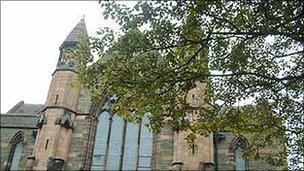Churches and chapels in Wales facing uncertain future
- Published
Rising repair bills, and dwindling heritage grants are threatening many listed churches and chapels, described as heritage treasures, across Wales. With closure hanging over them, some are turning to innovative means to keep their doors open.
At the Sunday service at St Paul's in Grangetown Cardiff, the congregation is in full voice but an old, broken heating system in the church has forced them to decamp to the hall next door.
Built in the Victorian age, St Paul's was designed to dazzle and generate awe.
But the giant arched nave has proved difficult to heat, even when it actually works. The windows are full of holes and the walls are covered with patches of damp.
As you walk between the pews, the floor slopes away, in part due to the marshland the church was originally built upon.
Such problems have left the church with a repair bill of between £500,000 and £1m. The building is on the market, a victim of the realisation that the funds to solve the problems may never be found.
The church's vicar, Father Ben Andrews, said: "We've got quite a healthy congregation; from babies to people in their 90s. It's a busy vibrant congregation. The church is part of the community.
"The building is important - but so too are the people. It will be a sad day if the church has to close but the parish are hoping we'll be able to build something new that is more low maintenance and user friendly in the hall next door."
St Paul's is one of more than 1,000 listed places of worship around Wales. And church organisations are finding it increasingly difficult to fund ongoing repairs needed to keep the buildings open for worship.
The gap between community donations and the total bill used to be narrowed by grants from bodies such as the Heritage Lottery Fund and Welsh heritage agency Cadw, as well as with support from bespoke funds such as the Listed Places of Worship scheme.
But in recent years these funds have become more difficult to obtain or their terms made more restrictive.
Cadw handed out repair grants totalling more than £500,000 to the Church in Wales last year, and more than £750,000 in total.
But requests for a further £200,000 for repairs were rejected due to over subscription.

St Paul's is one of more than 1,000 listed places of worship around Wales
Heritage Minister Alun Ffred Jones said churches and chapels were a vital part of the country's history and culture and central to helping our understanding of the past.
He said about a third of Cadw's grants for building repairs went to churches and chapels.
"I acknowledge the need is greater than the money available and would dearly love to release more money to help preserve and restore our churches and chapels," he said.
"But in the present circumstances I doubt whether we can find more money for this particular cause."
Solar panels
Alex Glanville, head of property services for the Church in Wales, said it should be remembered that each and everyone of its listed buildings were looked after by their own congregation.
"They are nationally listed but the local congregation has the immense challenge of trying to find money and resources," he said.
The Church in Wales says it needs £12m a year to repair its 1,000 listed churches.
Each year it manages to raise up to half of that - leaving a large shortfall that grants and government funds can no longer bridge.
"We are getting to about a third or a half of what we ideally need to look after these buildings properly. That's fantastic but some way short of what's needed," added Mr Glanville.
Increasingly parishes are coming up with new and innovative ways to serve their community - changes that can also help pay for repairs and upkeep.
In Cwmaman, in the south Wales Valleys, St Joseph's Church was facing closure.
But it turned to technology - installing solar panels on the roof to cut down on heating and electricity costs, and putting in an IT lab which can be used by the entire community.
Father David Way, said: "It might be unusual to see a computer in the middle of a church. But it's part of the imaginative way we had to look at the future of the church.
"The solar panels help with lighting and save us an enormous amount. We're actually able to sell electricity back to the National Grid.
"The church now has a future. Before the work, we were about to close."
St Michael's church at Michaelston-super-Ely, near Cardiff has stood as a place of worship for hundreds of years but last year shut its doors.
The near-by church at St Fagan's now absorbing their small congregation.
Mr Glanville said closure of a church or chapel was a great loss to a community for many reasons.
"The community is losing a significant building, an iconic building. But it's also losing an immensely important heritage asset."
- Published9 December 2010